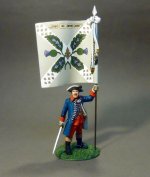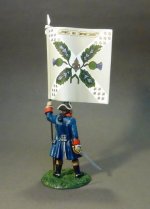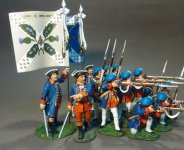Announcing the Final Special Collectors’ club set for 2014.
JJ DESIGNS COLLECTORS’ CLUB SET#21
STATUS –PRE-ORDER, 1st JANUARY- 31st JANUARY 2015
The two battalions of this regiment operated on different theatres of operation for most of the Seven Years' War. The 1st Battalion remained in Europe while the 2nd was sent to Canada. The Colonels’ Colour remained with the 1st Battalion in Europe.
The Colonels’ Colours were a white field with a white cross (this was the regular colonel colour carried by most French infantry regiment).
During the Seven Years' War, the regiment ranked 72nd and was under the command of , from 1735 to 1748 Vincent Sylvestre de Thimbrune, Comte de Valence and from January 1 1748 to November 25 1762: Chevalier de Thimbrune de Valence
The regiment was disbanded on November 25 1762. Its grenadiers and officers were incorporated into the Grenadiers de France while its sergeants, corporals, fusiliers and drummers were offered the opportunity to serve at Saint-Domingue in the colonies by joining the Boulonnais, Foix or Quercy regiments.
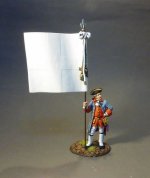
JJCLUBSET#21
THE SEVEN YEARS WAR, FRENCH INFANTRY, REGIMENT de BEARN,
OFFICER WITH COLONELS’ COLOUR,
(2pcs)
Limited Edition (TBA)
Retail us$59
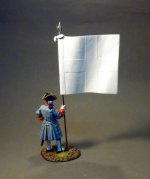
JJ DESIGNS COLLECTORS’ CLUB SET#20
STATUS –PRE-ORDER, 1st JANUARY- 31st JANUARY 2015
In the year 1739, the six independant companies of the "Highland Watch", along with four newly-raised companies, were incorporated into a Regiment of Foot under John, the Earl of Crawford. This Regiment was originally numbered the 43rd Highland Regiment, but was renumbered as the 42nd in 1749.
The 42nd was sent to New York in 1756, and fought in the first battle of Fort Ticonderoga in 1758, losing over half its troops in a valiant assault on the breastworks. Prior the the action at Ticonderoga, the 42nd was given the distinction of being a "Royal" regiment, changing the uniform's facings from buff to royal blue, and earning the right to bear a distinctive seal on the colours and drums. The regiment was known from then on as The 42nd (Royal Highland) Regiment or Royal Highlanders.
The 42nd is rich in tradition from the battle. Foremost is the account surrounding the death of the regiment’s major, Duncan Campbell of Inverawe. The 42nd was a Campbell regiment. All 5 officer casualties at Fontenoy in 1745 had been Campbells. At some time in the 1740s Inverawe had been involved in concealing a fugitive. When it turned out the man had murdered his cousin, Inverawe turned him out in breach of a promise he had made. The fugitive appeared in a dream to Inverawe and said “I will see you at Ticonderoga”. By 1758 Inverawe had served in the Black Watch for some 20 years and was the major. Only on his arrival in America did he discover the existence of Ticonderoga. The fugitive appeared again to Inverawe in a dream the night before the battle the bloodstained figure predicted his death. Inverawe was severely wounded in the battle and died at Fort Edward after his arm had been amputated.
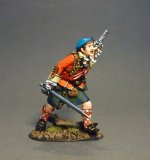
JJCLUBSET#20
BATTLE OF FORT CARILLON, TICONDEROGA 8th JULY 1758, 42nd REGIMENT OF FOOT,
Major Duncan Campbell of Inverawe,
(1pc)
Limited Edition (TBA)
Retail us$45
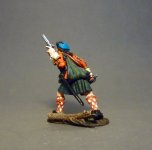
More to follow............................................
JJ DESIGNS COLLECTORS’ CLUB SET#21
STATUS –PRE-ORDER, 1st JANUARY- 31st JANUARY 2015
The two battalions of this regiment operated on different theatres of operation for most of the Seven Years' War. The 1st Battalion remained in Europe while the 2nd was sent to Canada. The Colonels’ Colour remained with the 1st Battalion in Europe.
The Colonels’ Colours were a white field with a white cross (this was the regular colonel colour carried by most French infantry regiment).
During the Seven Years' War, the regiment ranked 72nd and was under the command of , from 1735 to 1748 Vincent Sylvestre de Thimbrune, Comte de Valence and from January 1 1748 to November 25 1762: Chevalier de Thimbrune de Valence
The regiment was disbanded on November 25 1762. Its grenadiers and officers were incorporated into the Grenadiers de France while its sergeants, corporals, fusiliers and drummers were offered the opportunity to serve at Saint-Domingue in the colonies by joining the Boulonnais, Foix or Quercy regiments.

JJCLUBSET#21
THE SEVEN YEARS WAR, FRENCH INFANTRY, REGIMENT de BEARN,
OFFICER WITH COLONELS’ COLOUR,
(2pcs)
Limited Edition (TBA)
Retail us$59

JJ DESIGNS COLLECTORS’ CLUB SET#20
STATUS –PRE-ORDER, 1st JANUARY- 31st JANUARY 2015
In the year 1739, the six independant companies of the "Highland Watch", along with four newly-raised companies, were incorporated into a Regiment of Foot under John, the Earl of Crawford. This Regiment was originally numbered the 43rd Highland Regiment, but was renumbered as the 42nd in 1749.
The 42nd was sent to New York in 1756, and fought in the first battle of Fort Ticonderoga in 1758, losing over half its troops in a valiant assault on the breastworks. Prior the the action at Ticonderoga, the 42nd was given the distinction of being a "Royal" regiment, changing the uniform's facings from buff to royal blue, and earning the right to bear a distinctive seal on the colours and drums. The regiment was known from then on as The 42nd (Royal Highland) Regiment or Royal Highlanders.
The 42nd is rich in tradition from the battle. Foremost is the account surrounding the death of the regiment’s major, Duncan Campbell of Inverawe. The 42nd was a Campbell regiment. All 5 officer casualties at Fontenoy in 1745 had been Campbells. At some time in the 1740s Inverawe had been involved in concealing a fugitive. When it turned out the man had murdered his cousin, Inverawe turned him out in breach of a promise he had made. The fugitive appeared in a dream to Inverawe and said “I will see you at Ticonderoga”. By 1758 Inverawe had served in the Black Watch for some 20 years and was the major. Only on his arrival in America did he discover the existence of Ticonderoga. The fugitive appeared again to Inverawe in a dream the night before the battle the bloodstained figure predicted his death. Inverawe was severely wounded in the battle and died at Fort Edward after his arm had been amputated.

JJCLUBSET#20
BATTLE OF FORT CARILLON, TICONDEROGA 8th JULY 1758, 42nd REGIMENT OF FOOT,
Major Duncan Campbell of Inverawe,
(1pc)
Limited Edition (TBA)
Retail us$45

More to follow............................................


